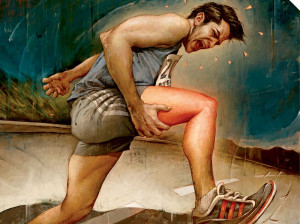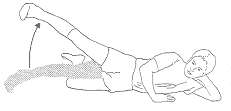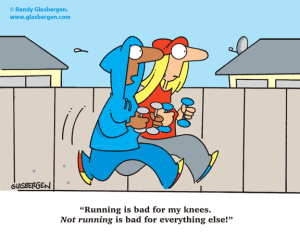Common Running Injuries

Runner’s World attended the Sports Science Institute Of South Africa “Common Running Injuries” workshop last night: these were the top tips that we took away regarding injury prevention:
A Little Bit Of Background:
- In the 1980s, a study revealed that 50% of all runners are likely to get an injury within the first year of running.
- This year, 16% of Two Oceans runners had an injury in the precious 12 months. 80% of these injuries were due to overuse, with 35% involving the knee!
Why do we get injured?
- The majority of running injuries are chronic, meaning that the pain is repetitive over period of time.
- Risk factors to picking up an injury: past history of injury, muscle imbalances, incorrect training, improper surfaces, incorrect shoes and inadequate nutrition.
- If you push yourself too hard or add too much distance or speed, you’re highly likely to get an injury. You know your limits: listen to them!
Injury Prevention
- Running on uneven surfaces is more natural and can help to correct imbalances. We werent designed to run on tar (or treadmills)! By running on uneven surfaces, our muscles are stimulated to work more, rather than going through the same repetitive motion. This muscle stimulation is effective in preventing injuries.
- Warming up correctly is more important that stretching! A warm up entails an easy 3-5 minute jog, only then followed by a stretch. You’re not just warming up your muscles, it’s your joints, too!
- Don’t hold a static stretch for longer than 30 seconds.
- When you stretch your calf, make sure you spend time stretching with the leg in question, bent: it works other areas of your calf muscle, too.
- Don’t underestimate the value of strength training in injury prevention!
- Don’t push your limits! You know what you’re capable of, push the boundaries too much and you’ll land up injured.
 “Side lying abduction” is probably the most important injury prevention exercise.
“Side lying abduction” is probably the most important injury prevention exercise.- Lying on your side with head resting on bottom arm, legs straight, and the top leg slightly behind the bottom one.
- Lift your top leg skyward, keeping your toes pointed straight ahead
- Return to start position and repeat for prescribed number of repetitions
- Switch legs and repeat
Got A Niggle? Now What?
- Don’t run through the pain! Figure out what have you’ve done differently and take note.
- Treat pain, but make sure that you don’t mask the pain (e.g. with medication)
- It’s not good enough to just treat the symptom, you need to find the cause!
- When going for a diagnosis, it’s vital to ask the practitioner: what structure is injured, and what exactly is wrong with it?
- The major concern runners have with injuries is losing cardiovascular fitness. A biokineticist can give you an alternative training programme to help you maintain fitness while you’re unable to run.
- Don’t wait too long to see an orthopedic surgeon (or any other health professional)! They need you to be experiencing symptoms in order to effectively diagnose your injury.
- The most common running injuries are: Runner’s knee, ITB, shin splints, tendon injury and muscle tears.
- Runner’s Knee is front knee pain. ITBS is side knee pain.
- Female runners are more likely to develop Runner’s Knee.
- Often ITBS is overdiagnosed! If you have ITBS, be careful of too much icing: it can cause additional problems in adjacent nerves. Stretching and foam rollers are important for ITBS treaetment.
- Shin pain (not splints) occurs in runner’s who are unconditioned and start a programme too quickly
What about barefoot / minimalist running?
- There is no one answer in the heel versus forefoot striking debate. You need to find what works for you!
- Ideally we should never have worn shoes – but at the same time, we’re no longer running on natural surfaces.Man made surfaces (concrete and tar) are hard to run on, and our bodies haven’t adapted to pound it, barefoot. Running on grass and easy trail are more suitable for true barefoot running.
- If you chose to go barefoot / minimalist, make sure the transition is slow! If you change too quickly, you’ll just end up with more injuries.
Source: http://www.runnersworld.co.za
previous link click ...[[back]] << top of the document >>
See also:
»Newer topics:
»Older topics:
»
![]() The Pros and Cons of Massages for Runners
The Pros and Cons of Massages for Runners
Research finally reveals just what massages can—and can't—do for runners.
![]() The Pros and Cons of Massages for Runners
The Pros and Cons of Massages for Runners
Research finally reveals just what massages can—and can't—do for runners.
See also:
»Newer topics:
»Older topics:
»
![]() Happy Hammies
Happy Hammies
four basic exercises for hammies
![]() Happy Hammies
Happy Hammies
four basic exercises for hammies
See also:
»Newer topics:
»Older topics:
»
![]() Stay on Course
Stay on Course
Common steps to keep healthy - in sports
![]() Stay on Course
Stay on Course
Common steps to keep healthy - in sports
See also:
»Newer topics:
»Older topics:
»
![]() Foam Rolling for Runners
Foam Rolling for Runners
foam-roller ---- deep-tissue-massage
![]() Foam Rolling for Runners
Foam Rolling for Runners
foam-roller ---- deep-tissue-massage




